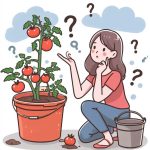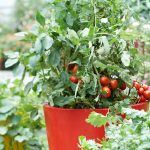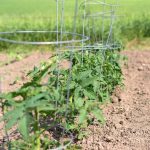The ultimate pot size for the tomato plant is 14 to 24 inches wider and 10-12 inch deep which measure 5-10 gallon of tomato plants. For small plants or determining tomato variety, 12-18 inches is perfect, and for indeterminate varieties 24 or more in diameter size is needed.
Tomato plants are heavy feeders and require a lot of nutrients to produce bountiful fruits. A 5-10 gallon pot will provide enough space for the roots to grow and access nutrients and moisture.
Once the plant starts to produce fruits, the weight of the tomatoes will cause the plant to lean over. A large pot will help support the plant and prevent it from toppling over.
What Size Container For Tomatoes (Ideal Pot Size)
| Pot Size | Tomato Variety | Plant Height |
| 12 -18 Inch | Orange Hat, Red Robin, Minibel, Tiny Totem, Better Bush | 6-18 Inch |
| 24 Inch | Super Sweet, Roma Tomato | 40-56 Inch |
| 30 Inch | Stupice, Black Krim, Beefsteak tomato | 60-72 Inch |
What are the factors that affect pot size for tomato plants?
A 64-year study of tomato plants consisting of 1000 plants and 70+ different species concluded that the optimum container size of 12 inches and depth of 10-12 inches perform the best result with less work for the gardener.
The study also showed that a larger pot size will not necessarily result in a higher yield.
Different factors that directly affect the pot size are the tomato variety and how many plants you want to grow. Some of the other factors that the experience says are-
Tomato Variety:
Different varieties of tomatoes have different root systems. Some varieties, such as determinate varieties, have a more compact root system and don’t need as much space to grow.
Indeterminate varieties have a more extensive root system and will need a larger pot to support the plant.
Number of Plants:
The number of plants you want to grow will also affect the pot size. If you only want to grow one, a small pot will suffice. If you want to grow several plants, you’ll need a larger pot so that each plant has enough space to grow.
However, it is recommended that each pot should have only one plant for better production and growth, regardless of the pot size.
Pot Mix:
The type of potting mix you use will also affect the pot size. A lightweight mix will take up less space than a heavier mix. This is something to keep in mind if you’re growing your plants in pots that are too small.
The roots will need more space to grow in a lightweight mix than in a heavyweight mix.

How Many Tomato Plants Should I Put in Each Pot?
The general rule of thumb is to plant one tomato plant per pot. Because tomato plants are heavy feeders, they will need all the space they can get to access nutrients and moisture.
A single plant in a pot will also be easier to care for than multiple plants.
If you’re growing determinate varieties, the vegetation will require less space, so you can choose the smaller pot size But for the indeterminate varieties, you’ll need a larger pot to accommodate the plant’s growth.
If you’re growing indeterminate varieties, it’s best to stick with one plant per pot with a cage or stake. These plants can grow quite large and will need all the space they can get.
Multiple plants in a pot will compete for space and resources, and the end result will be smaller fruits and fewer fruits overall.
What Is Better for Tomato Plant – Pot or Soil?
Tomatoes can be grown in containers and soil. Large-scale tomato cultivation of South Asian origin is organized in soil with taking proper care and precaution.
However, it’s quite popular for the gardener in American culture to grow tomatoes in containers on the patio or balcony. The following will help you to know more about it.
The Difference Between Pots and Soil:
When growing tomatoes in pots, the plants are confined to a smaller space than when they’re grown in soil. This means that the roots have less space to spread out and access nutrients and moisture.
To offset this, you’ll need to use a potting mix that’s specifically designed for container gardening. This mix will be lighter than traditional garden soil and will contain more organic matter.
It will also be augmented with fertilizer to help the plants access the nutrients they need.
When growing tomatoes in soil, you have the advantage of a larger space for the roots to spread out. This allows the plant to access more nutrients and moisture.
Garden soil also tends to be heavier than potting mix, so it will hold moisture better and require less frequent watering.
There are some notable differences between tomatoes grown in pots and soil-
Benefits of Soil:
- A greater volume of soil available leads to a larger root system.
- A greater root system results in better absorption of water and nutrients.
- Warmer soil temperature leads to earlier fruit production.
- Soil is less likely to dry out than potting mix, so plants will need less frequent watering.
Benefits of Pots:
- Pots can be moved to take advantage of sunlight and heat.
- Pots can be placed on a windowsill or another location where they will get the most light.
- Pots allow for better drainage than soil, so plants are less likely to experience root rot.
- Pots are an easy way to start tomatoes from seed.
Do Potted Tomato Plant Need Mulch?
Potted tomato plants need mulch to help with drainage and to keep the roots warm. The best type of mulch for a potted tomato plant is a coarse one that will not break down quickly.
Some good choices for mulch include pebbles, straws, and wood bark mulch.
Adding a layer of mulch to your potted tomato plant will help to keep the soil moist and will also help to protect the roots from extreme temperatures.
Mulching also helps to prevent weeds from growing and competing with your tomato plant for water and nutrients.
What Size Pot for Indoor Tomatoes?
Generally, Indoor tomatoes are small and compact varieties that can be grown in pots as small as 3 gallons. However, 5-gallon pots are ideal for most indoor tomato plants. If you are growing a determinate or dwarf variety, you may be able to get away with using a 2-gallon pot. But I would not recommend going any smaller than that.
Some indeterminate tomato varieties can be grown on indoor trellises or in hanging baskets. In these cases, you will need to choose a pot that is large enough to accommodate the plant’s root system and has drainage holes in the bottom.
If you’re hoping to have a bountiful tomato harvest, be sure to select the right variety of tomato plants for indoor. Some varieties like Mountain Spring mature at 72 days, and Tiny Tim matures at 45 days can be a better option for indoor cultivation.
What Size Pot for Tomato Seeds?
Though tomato seeds are best for seedling trays where they can get much care and regular watering, some gardeners prefer to start them in pots. If you are growing your tomato plants in pots, you need to know what size pot is best for your needs.
Tomato seeds are small, so they don’t need a lot of room to sprout. A 2-inch pot is adequate for most tomato seedlings. You can choose single-use/ disposable plastic glass. Once the tomato seedlings have sprouted and are ready to be transplanted, they can be moved to a 4- or 6-inch pot.
If you’re growing larger varieties of tomatoes, you’ll need to start them in a larger pot. A 3-gallon pot is a good size for most large varieties of tomatoes.

What Size Pots For Tomato In Greenhouse?
The size of the pot you use for your tomato plants in the greenhouse will depend on the variety of tomatoes you are growing. For most varieties, a 5-gallon pot is large enough.
If you are growing a dwarf or determinate variety, you can get away with using a 3-gallon pot.
As the greenhouse is covered with a transparent material, the temperatures inside will be higher than outside. So, it is important to choose a pot that is made from a material that will not absorb and radiate too much heat.
Some good materials for greenhouse tomato pots include ceramic, clay, and plastic.
But you can use fabrics, air pots, and other materials that have good drainage and won’t overheat the roots of your plants.
You can re-arrange the pots in a line under the shade and make the stake of each pot touch the ground to provide good support.
In Greenhouse cultivation, Two years of research have shown that tomatoes grown in raised beds or soil containers can yield better results than those grown in traditional potting media.
By alternating or changing the growing medium throughout the cultivation process, you can achieve similar effects and produce a perfect crop at the end of the season.
All you have to do is pot and submerge the roots in the medium. And it doesn’t matter how big or small of a container you use for your greenhouse or tomato plant.
Just make sure there’s an optimum pot size which I discussed before, good drainage to avoid overwatering your plants, and that the material won’t get too hot and damage the roots.
Conclusion:
To summarize, if you maintain the ideal size of a 14-24 inch pot/container containing 5-10 gallon measure and give it proper care with organic methods, your tomato plants will yield a good crop.
Also, using a high-quality potting mix is very important to provide the necessary drainage and aeration to the plant roots.
And finally, adding mulch will help protect the roots and soil from extreme temperatures while also preventing weeds.

I am a graduate of Bangladesh Agricultural University, where I delved into various agricultural disciplines, equipping me with a profound understanding of agriculture. Beyond academics, I have hands-on experience in gardening and crop cultivation. My passion is to embrace sustainable farming and horticulture. With a BSc in Agriculture, I am dedicated to promoting environmentally conscious and efficient agrarian practices.
Bachelor of Science (BSc) in Agriculture (Hons.)
Master of Science. (Sustainable Agriculture & Food Security ) (MS)
Bangladesh Agricultural University




